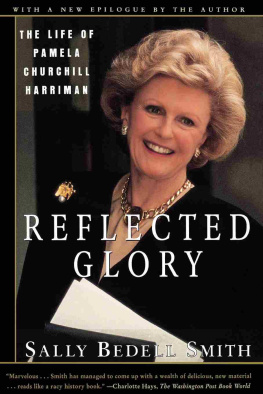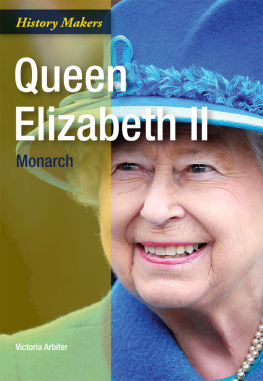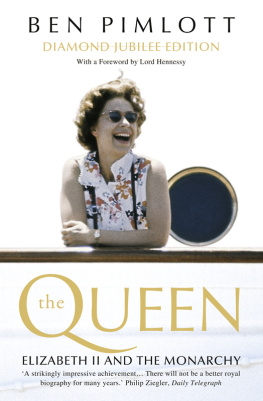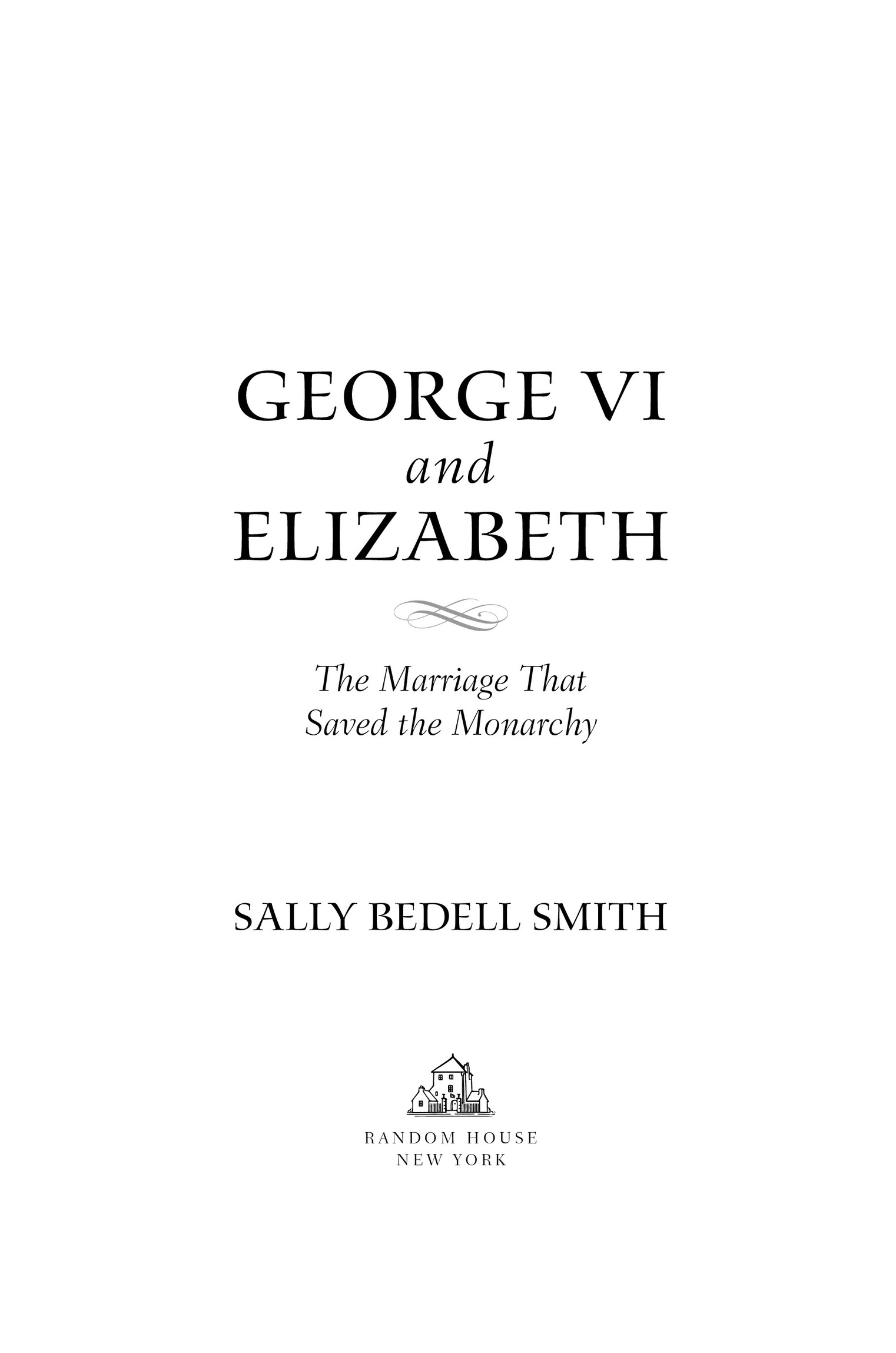King George VI and Queen Elizabeth with Princesses Elizabeth and Margaret in coronation robes and crowns.
Copyright 2023 by Sally Bedell Smith
All rights reserved.
Published in the United States by Random House, an imprint and division of Penguin Random House LLC, New York.
Random House and the House colophon are registered trademarks of Penguin Random House LLC.
Grateful acknowledgment is made to Curtis Brown, London, for permission to reprint excerpts from both the published and unpublished diaries of Harold Nicolson, The Estate of Harold Nicolson. Published diary quotes are taken from Diaries and Letters 19301939 by Harold Nicolson, edited by Nigel Nicolson (New York: Atheneum Books, 1966), The War Years 19391945, Volume II of the Diaries and Letters by Harold Nicolson, edited by Nigel Nicolson (New York: Atheneum Books, 1967), and The Later Years 19451962 by Harold Nicolson, edited by Nigel Nicolson (New York: Atheneum Books, 1968). Used by permission of Curtis Brown, London.
Library of Congress Cataloging-in-Publication Data
Names: Smith, Sally Bedell, author.
Title: George VI and Elizabeth : the marriage that saved the monarchy / Sally Bedell Smith.
Description: New York : Random House, 2023. | Includes bibliographical references and index.
Identifiers: LCCN 2022017389 (print) | LCCN 2022017390 (ebook) | ISBN 9780525511632 (hardcover) | ISBN 9780525511656 (ebook)
Subjects: LCSH: George VI, King of Great Britain, 18951952. | Elizabeth, Queen, consort of George VI, King of Great Britain, 19002002. | George VI, King of Great Britain, 18951952Marriage. | Elizabeth, Queen, consort of George VI, King of Great Britain, 19002002Marriage. | Marriages of royalty and nobilityGreat BritainHistory20th century. | Great BritainKings and rulersBiography. | QueensGreat BritainBiography. | Royal couplesGreat BritainBiography. | MonarchyGreat BritainHistory20th century. | Great BritainHistoryGeorge VI, 19361952.
Classification: LCC DA584 .S65 2023 (print) | LCC DA584 (ebook) | DDC 941.0840922dc23/eng/20220426
LC record available at https://lccn.loc.gov/2022017389
LC ebook record available at https://lccn.loc.gov/2022017390
Ebook ISBN9780525511656
randomhousebooks.com
Book design by Susan Turner, adapted for ebook
Cover design: Belina Huey
Cover photograph: Cecil Beaton/Victoria and Albert Museum
ep_prh_6.0_143000293_c0_r0
Contents
_143000293_
A NOTE ON ROYAL NAMES
Names in the royal family are inconsistent and often puzzling, partly due to habitual nicknaming, but more because of the inevitable changes that come with the progression of titles, especially among those first in line to the throne.
For the purposes of this book, King George VI will be variously known as Prince Albert (his given name); Albert; Bertie, his nickname in the family throughout his life; the Duke of Yorkthe title his father gave him in 1920; George VI, the name he chose from among his four Christian names when he ascended the throne in 1936; and the King.
Queen Elizabeth will be referred to as Lady Elizabeth Bowes Lyon; Elizabeth; the Duchess of Yorkher title on marrying Albert, the Duke of York, in 1923; Queen Elizabeth, the title she took on her husbands accession in 1936; the Queen; and the Queen Mother after the death of her husband in 1952.
Princess Elizabeth, the future Queen Elizabeth II, will be referred to as Princess Elizabeth, her name from birth; Lilibet, the nickname from childhood she gave herself; Queen Elizabeth II on taking the throne in February 1952; and the Queen.
Princess Margaret, the younger daughter of George VI and Queen Elizabeth, will be called Princess Margaret, her birth name, and Margaret.
King George V will be called first Prince George, then George V.
Queen Mary will be referred to initially as Princess May, as she was known from the time of her birth, and Queen Mary after her husband, George V, took the throne in 1910.
King Edward VIII, the older brother of King George VI, will be called Prince Edward or Edward, as well as David, his name within the family; the Prince of Waleshis title from 1910 until he became king in January 1936 on the death of George V; and the Duke of Windsorthe title his brother gave him after the abdication in December 1936.
Wallis Warfield Simpson, the Duke of Windsors wife, will be called Mrs. Simpson, Wallis, and the Duchess of Windsor following her marriage to the duke in 1937.
Prince Henry, a younger brother of George VI, will be called Henry rather than Harry, his family nickname (to avoid confusion with his sister Marys husband, also nicknamed Harry), and the Duke of Gloucester, the title given him in 1928 by his father, George V.
Princess Alice, Duchess of Gloucester, will be called the Duchess of Gloucester and Alice. (It was not until the death of her husband in 1974 that Queen Elizabeth II designated her aunt as a princess.)
Prince George, another younger brother of George VI, will be called Prince George, but also Georgie, his family nickname; he will also be referred to as the Duke of Kent, the title given him by King George V in 1934.
Princess Marina, the wife of Prince George, will be called Princess Marina, the Duchess of Kent, and Marina.
Princess Mary, the younger sister of George VI, will be called Princess Mary.
Henry Lascelles, the sixth Earl of Harewood (pronounced Hahrwood), Princess Marys husband, will be called Harry Lascelles and later Harry Harewood, when he inherited the earldom in 1929 on his fathers death.
Prince John, the youngest brother of George VI, will be called Prince John and Johnnie, as he was known in the family until his death at age thirteen in 1919 from a major epileptic seizure.
Other historical and collateral members of the royal family will be known by their given titles: for example, King Edward VII or Edward VII and Queen Alexandra or Alexandra, the grandparents of King George VI.
In the interests of simplicity, the terms His or Her Royal Highness and His or Her Majesty will be avoided except in specific circumstances or when mentioned in a direct quotation.
They were more resilient and strong-minded than they appeared to be.
King George VI and Queen Elizabeth on their twenty-fifth wedding anniversary, April 26, 1948.
PROLOGUE
It is a big claim to say that a single royal couple saved the centuries-old British monarchy. But King George VI and Queen Elizabeth, later known as the Queen Mother (or Queen Mum in affectionate slang), did exactly that, by an accident of history and through personal qualities that earned the admiration and support of the British public. They imparted their values and sense of duty to their daughter Elizabeth, who succeeded her father in 1952. As Queen Elizabeth II, she became the longest-reigning monarch in British history and arguably the most popular.
















